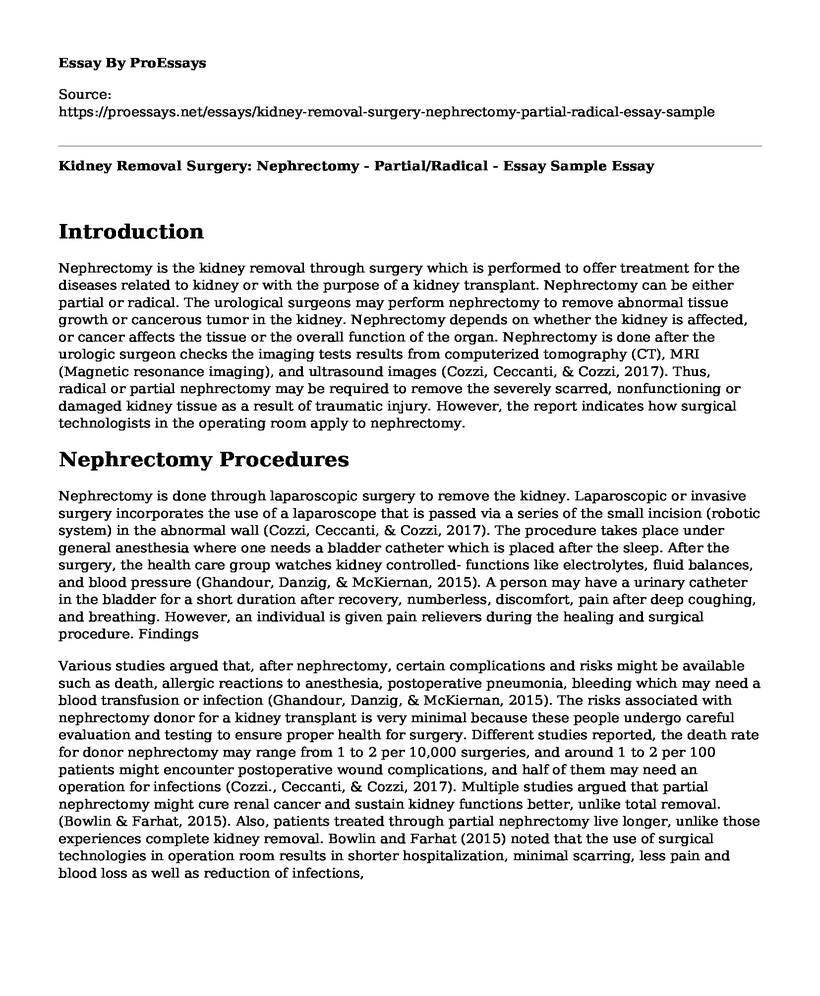Introduction
Nephrectomy is the kidney removal through surgery which is performed to offer treatment for the diseases related to kidney or with the purpose of a kidney transplant. Nephrectomy can be either partial or radical. The urological surgeons may perform nephrectomy to remove abnormal tissue growth or cancerous tumor in the kidney. Nephrectomy depends on whether the kidney is affected, or cancer affects the tissue or the overall function of the organ. Nephrectomy is done after the urologic surgeon checks the imaging tests results from computerized tomography (CT), MRI (Magnetic resonance imaging), and ultrasound images (Cozzi, Ceccanti, & Cozzi, 2017). Thus, radical or partial nephrectomy may be required to remove the severely scarred, nonfunctioning or damaged kidney tissue as a result of traumatic injury. However, the report indicates how surgical technologists in the operating room apply to nephrectomy.
Nephrectomy Procedures
Nephrectomy is done through laparoscopic surgery to remove the kidney. Laparoscopic or invasive surgery incorporates the use of a laparoscope that is passed via a series of the small incision (robotic system) in the abnormal wall (Cozzi, Ceccanti, & Cozzi, 2017). The procedure takes place under general anesthesia where one needs a bladder catheter which is placed after the sleep. After the surgery, the health care group watches kidney controlled- functions like electrolytes, fluid balances, and blood pressure (Ghandour, Danzig, & McKiernan, 2015). A person may have a urinary catheter in the bladder for a short duration after recovery, numberless, discomfort, pain after deep coughing, and breathing. However, an individual is given pain relievers during the healing and surgical procedure. FindingsVarious studies argued that, after nephrectomy, certain complications and risks might be available such as death, allergic reactions to anesthesia, postoperative pneumonia, bleeding which may need a blood transfusion or infection (Ghandour, Danzig, & McKiernan, 2015). The risks associated with nephrectomy donor for a kidney transplant is very minimal because these people undergo careful evaluation and testing to ensure proper health for surgery. Different studies reported, the death rate for donor nephrectomy may range from 1 to 2 per 10,000 surgeries, and around 1 to 2 per 100 patients might encounter postoperative wound complications, and half of them may need an operation for infections (Cozzi., Ceccanti, & Cozzi, 2017). Multiple studies argued that partial nephrectomy might cure renal cancer and sustain kidney functions better, unlike total removal. (Bowlin & Farhat, 2015). Also, patients treated through partial nephrectomy live longer, unlike those experiences complete kidney removal. Bowlin and Farhat (2015) noted that the use of surgical technologies in operation room results in shorter hospitalization, minimal scarring, less pain and blood loss as well as reduction of infections,
Conclusion
Surgical technologists in the operating room apply to nephrectomy because kidney removal is done when a person has kidney damage, cancer, not functioning or when donating. The doctor removes the kidney through laparoscopic or open surgery. The recovery from nephrectomy surgery should take a maximum of three to six weeks, so, the doctor monitors the progress. However, the complications associated with nephrectomy include loss of blood, heart attack, stroke, infections, and breathing difficulties.
Recommendation
After nephrectomy, it is vital to maintain the normal functioning of the kidney. In preserving the organ, the doctor recommends a healthy diet, daily physical exercise, and attending regular kidney checkups. The doctor also recommends lifestyle changes in the case of chronic kidney conditions like dietary changes and medications. However, people should have checkups to monitor kidney functions like protein urine levels, waste filtration, and blood pressure.
References
Bowlin, P. R., & Farhat, W. A. (2015). Laparoscopic nephrectomy and partial nephrectomy: intraperitoneal, retroperitoneal, single site. Urologic Clinics, 42(1), 31-42. https://doi.org/10.1016/j.ucl.2014.09.012
Cozzi, D. A., Ceccanti, S., & Cozzi, F. (2017). Renal function recovery after nephrectomy or nephron-sparing surgery in children with unilateral renal tumor. European Journal of Pediatric Surgery, 27(01), 074-080. https://doi.org/10.1055/s-0036-1587336
Ghandour, R. A., Danzig, M. R., & McKiernan, J. M. (2015). Renal cell carcinoma: risks and benefits of nephron-sparing surgery for T1 tumors. Advances in chronic kidney disease, 22(4), 258-265. https://doi.org/10.1053/j.ackd.2015.03.006
Cite this page
Kidney Removal Surgery: Nephrectomy - Partial/Radical - Essay Sample. (2023, Feb 20). Retrieved from https://proessays.net/essays/kidney-removal-surgery-nephrectomy-partial-radical-essay-sample
If you are the original author of this essay and no longer wish to have it published on the ProEssays website, please click below to request its removal:
- Terra Sylva School
- Essay Sample on Managing Sleep Disorder in the Elderly
- Ensuring Quality Maternal Healthcare for Women in the US: A Systematic Issue - Essay Sample
- Essay Example on World Population: Characteristics of Women Population
- Explore the World of Radioisotopes: How They Are Produced - Essay Sample
- People with IDD: Equal Rights to Decision Making and Support for Health Care - Essay Example
- Nurses' Collective Bargaining: Protecting Rights Since 1935 - Free Report Example







